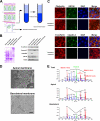Lipid polarity is maintained in absence of tight junctions
- PMID: 22294698
- PMCID: PMC3308754
- DOI: 10.1074/jbc.M111.327064
Lipid polarity is maintained in absence of tight junctions
Abstract
The role of tight junctions (TJs) in the establishment and maintenance of lipid polarity in epithelial cells has long been a subject of controversy. We have addressed this issue using lysenin, a toxin derived from earthworms, and an influenza virus labeled with a fluorescent lipid, octadecylrhodamine B (R18). When epithelial cells are stained with lysenin, lysenin selectively binds to their apical membranes. Using an artificial liposome, we demonstrated that lysenin recognizes the membrane domains where sphingomyelins are clustered. Interestingly, lysenin selectively stained the apical membranes of epithelial cells depleted of zonula occludens proteins (ZO-deficient cells), which completely lack TJs. Furthermore, the fluorescent lipid inserted into the apical membrane by fusion with the influenza virus did not diffuse to the lateral membrane in ZO-deficient epithelial cells. This study revealed that sphingomyelin-cluster formation occurs only in the apical membrane and that lipid polarity is maintained even in the absence of TJs.
Figures





Similar articles
-
A lipid-specific toxin reveals heterogeneity of sphingomyelin-containing membranes.Biophys J. 2004 Jan;86(1 Pt 1):296-307. doi: 10.1016/S0006-3495(04)74105-3. Biophys J. 2004. PMID: 14695271 Free PMC article.
-
Modulation of epithelial cell polarity by bacterial pathogens.Ann N Y Acad Sci. 2017 Oct;1405(1):16-24. doi: 10.1111/nyas.13388. Epub 2017 Jun 19. Ann N Y Acad Sci. 2017. PMID: 28628193 Free PMC article. Review.
-
Visualization of the heterogeneous membrane distribution of sphingomyelin associated with cytokinesis, cell polarity, and sphingolipidosis.FASEB J. 2015 Feb;29(2):477-93. doi: 10.1096/fj.13-247585. Epub 2014 Nov 11. FASEB J. 2015. PMID: 25389132
-
Tight Junction Structure and Function Revisited.Trends Cell Biol. 2020 Oct;30(10):805-817. doi: 10.1016/j.tcb.2020.08.004. Epub 2020 Sep 2. Trends Cell Biol. 2020. PMID: 32891490 Review.
-
Tumor suppressor scribble regulates assembly of tight junctions in the intestinal epithelium.Am J Pathol. 2010 Jan;176(1):134-45. doi: 10.2353/ajpath.2010.090220. Epub 2009 Dec 3. Am J Pathol. 2010. PMID: 19959811 Free PMC article.
Cited by
-
Roles of membrane lipids in the organization of epithelial cells: Old and new problems.Tissue Barriers. 2018;6(2):1-8. doi: 10.1080/21688370.2018.1502531. Epub 2018 Aug 29. Tissue Barriers. 2018. PMID: 30156967 Free PMC article. Review.
-
Tight junctions: from simple barriers to multifunctional molecular gates.Nat Rev Mol Cell Biol. 2016 Sep;17(9):564-80. doi: 10.1038/nrm.2016.80. Epub 2016 Jun 29. Nat Rev Mol Cell Biol. 2016. PMID: 27353478 Review.
-
How cells tell up from down and stick together to construct multicellular tissues - interplay between apicobasal polarity and cell-cell adhesion.J Cell Sci. 2021 Nov 1;134(21):jcs248757. doi: 10.1242/jcs.248757. Epub 2021 Oct 29. J Cell Sci. 2021. PMID: 34714332 Free PMC article. Review.
-
Organelle membrane-specific chemical labeling and dynamic imaging in living cells.Nat Chem Biol. 2020 Dec;16(12):1361-1367. doi: 10.1038/s41589-020-00651-z. Epub 2020 Sep 21. Nat Chem Biol. 2020. PMID: 32958953
-
Binding between the junctional proteins afadin and PLEKHA7 and implication in the formation of adherens junction in epithelial cells.J Biol Chem. 2013 Oct 11;288(41):29356-68. doi: 10.1074/jbc.M113.453464. Epub 2013 Aug 29. J Biol Chem. 2013. PMID: 23990464 Free PMC article.
References
-
- Gassama-Diagne A., Yu W., ter Beest M., Martin-Belmonte F., Kierbel A., Engel J., Mostov K. (2006) Phosphatidylinositol 3,4,5-trisphosphate regulates the formation of the basolateral plasma membrane in epithelial cells. Nat. Cell Biol. 8, 963–970 - PubMed
Publication types
MeSH terms
Substances
LinkOut - more resources
Full Text Sources

